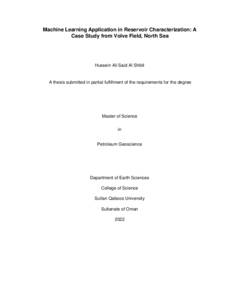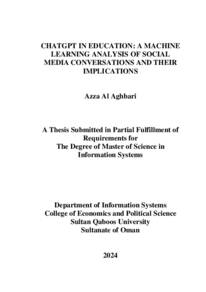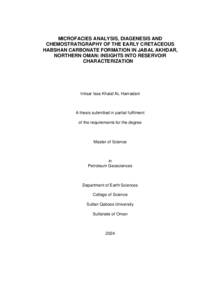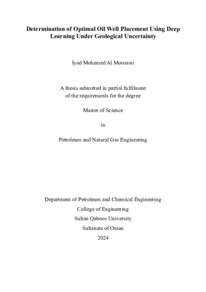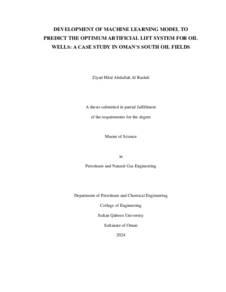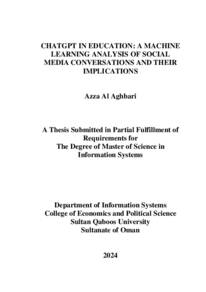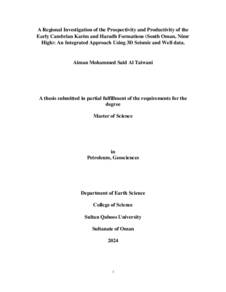Document
Machine learning application in reservoir characterization : a case study from Volve Field, North Sea.
Other titles
تطبيقات التعلم الآلي في صفات مكامن النفط : دراسة من حقل فولف, البحر الشمالي
Publisher
Sultan Qaboos University.
Gregorian
2022
Language
English
English abstract
Machine learning techniques provide an automated solution for reservoir characterization
and for the prediction of Petrophysical properties far from well locations. Porosity is one
of the essential attributes of reservoir rocks as it determines the amount of fluid a rock
can contain. The Hugin sandstone reservoir in the Volve field from North Sea Norway is
a thin reservoir with high variation in sand quality. This thickness variation poses
challenges in predicting reliable reservoir properties and consequently influences the
reserves and production forecasts. This study aims to enhance the characterization of
the Hugin Formation reservoir using different seismic interpretation techniques and
Machine Learning approaches.
To achieve this objective, different porosity prediction approaches are tested. The
methods are evaluated and tested at the well locations before applying them on the
seismic data. A large number of attributes is prepared for this task. This includes P impedance, S-impedance, Vp/Vs, Lambda-Rho, Mu-Rho, among others. The supervised
process started with Single Attributes Regression where individual attributes are
assessed to find a relationship with the reservoir porosity. Then, Multi Attribute
Regression is used to combine multiple attributes to improve the relationship found
between attributes and the porosity. Eventually, Neural Networks namely Deep Feed
Forward Neural Network (DFNN) and Probabilistic Neural Network (PNN) are utilized to
search for better and more accurate relationships with higher correlation between the
input attributes and the porosity. The Probabilistic Neural Network showed a very good
capability in predicting the porosity from the input seismic attributes. The predicted
porosity map of the reservoir revealed the distribution of the Hugin Formation facies. In
addition, the unsupervised Machine Learning helped classifying the reservoir into classes
that are found consistent with the facies defined by the PNN.
Member of
Resource URL
Arabic abstract
توفر تقنيات التعلم الآلي حلا أكثر آلية لتوصيف المكامن وتنبؤات أكثر دقة للخصائص البتروفيزيائية بعيدا عن مواقع الابار. تعد المسامية إحدى السمات الاساسية لصخور الخزان لأنها تحدد كمية السوائل التي يمكن أن يحتويها الصخر. يتميز مكمن الحجر الرملي هجين في حقل فولف من بحر الشمال النرويجي بسمك منخفض وتباين كبير في جودة الرمال. يطرح هذا الاختلاف في السماكة تحديات في التنبؤ بخصائص المكمن الفعاله وبالتالي يؤثر على الاحتياطيات وتوقعات الانتاج. تهدف هذه الدراسة إلى تعزيز توصيف خزان تكوين هجين باستخدام تقنيات التفسير الزلزالي المختلفة وأساليب التعلم الآلي. لتحقيق هذا الهدف، تم اختبار مناهج مختلفة للتنبؤ بالمسامية. تم تقييم واختبار الطرق في مواقع الابار قبل تطبيقها على البيانات الزلزالية. تم إعداد عدد كبير من السمات لهذه المهمة. وهذا يشمل impedance-P و impedance-S و Vs/Vp و Rho-Lambda و Rho-Mu وغيرها. بدأت العملية الخاضعة لللإشراف بانحدار السمات الفردية حيث يتم تقييم السمات الفردية إليجاد عالقة مع مسامية الخزان. بعد ذلك ، يتم استخدام انحدار السمات المتعددة لدمج سمات متعددة لتحسين العالقة الموجودة بين السمات والمسامية. في نهاية المطاف ، يتم استخدام الشبكات العصبية ، وهي الشبكة العصبية للتغذية العميقة )DFNN )والشبكة العصبية الاحتمالية )PNN )للبحث عن علاقات أفضل وأكثر دقة مع ارتباط أعلى بين سمات الادخال والمسامية. أظهرت الشبكة العصبية الاحتمالية قدرة جيدة جدًا في التنبؤ بالمسامية من السمات الزلزالية للإدخال. كشفت خريطة المسامية المتوقعة للخزان عن توزيع سحنات تكوين هجين. بالاضافة إلى ذلك ، ساعد التعلم الآلي غير الخاضع للإشراف في تصنيف الخزان إلى فئات وجدت متسقة مع السحنات المحددة بواسطة PNN.
Category
Theses and Dissertations

